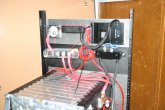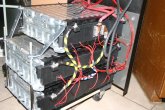I have some large BMW batteries
They range in 3s, 4s, and 5s packs, i have them configured so that i have 14s groups. i can make up to 6 strings, but for now i will start off with 2 and see how much more I can add in the future.
But for now I am searching for a good BMS, one with active top and bottom balancing, multi thermal sensor capabilitys ( I'd like to use the thermal sensors on the battery if i can. )
I have heard that Orion , Batrium and REC were pretty good units, but picking the one i need seems to be over my head.
I know i'll probably need one BMS for each string I have.
I need suggestions.
Thanks.
They range in 3s, 4s, and 5s packs, i have them configured so that i have 14s groups. i can make up to 6 strings, but for now i will start off with 2 and see how much more I can add in the future.
But for now I am searching for a good BMS, one with active top and bottom balancing, multi thermal sensor capabilitys ( I'd like to use the thermal sensors on the battery if i can. )
I have heard that Orion , Batrium and REC were pretty good units, but picking the one i need seems to be over my head.
I know i'll probably need one BMS for each string I have.
I need suggestions.
Thanks.






